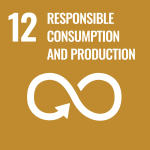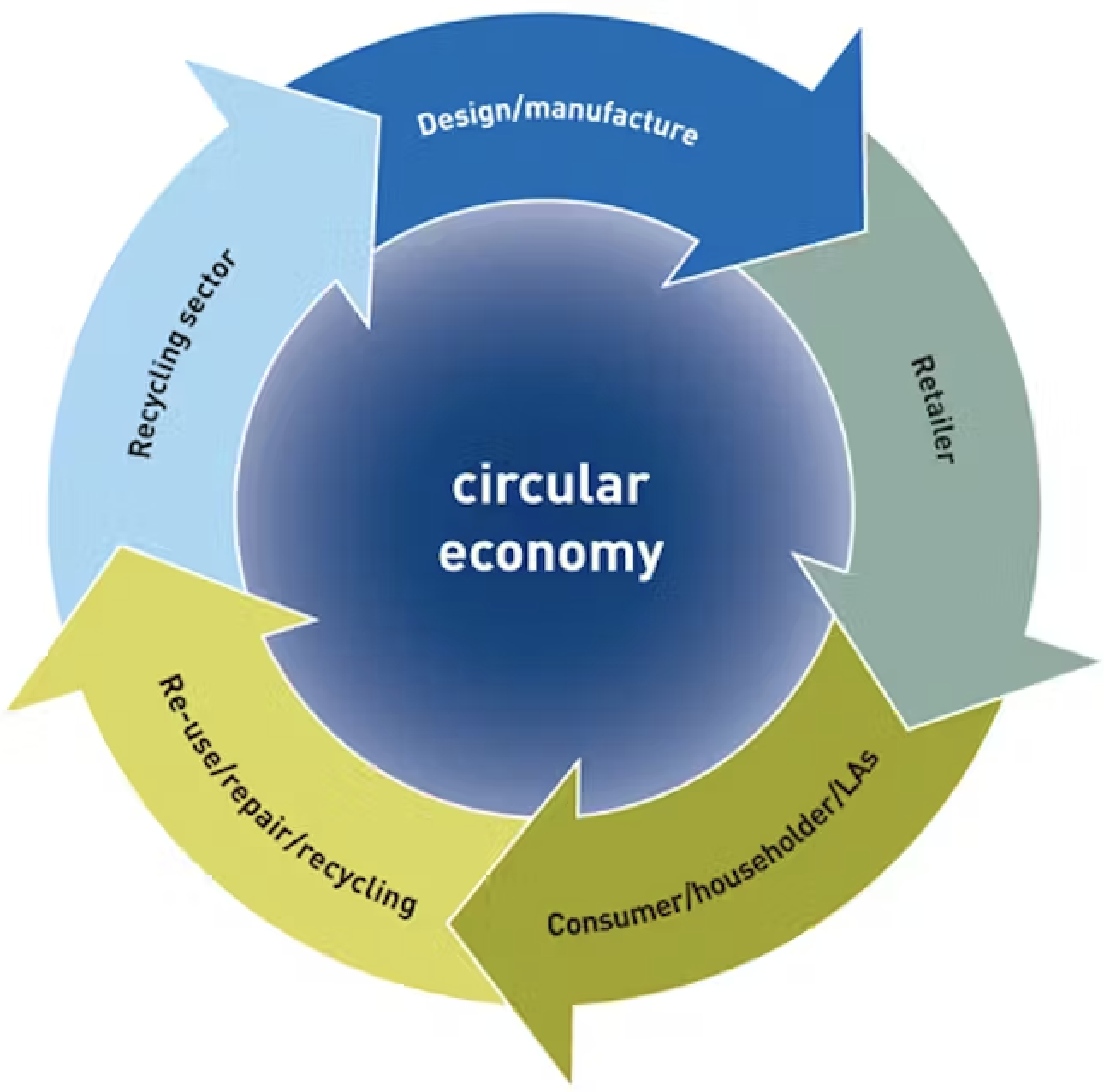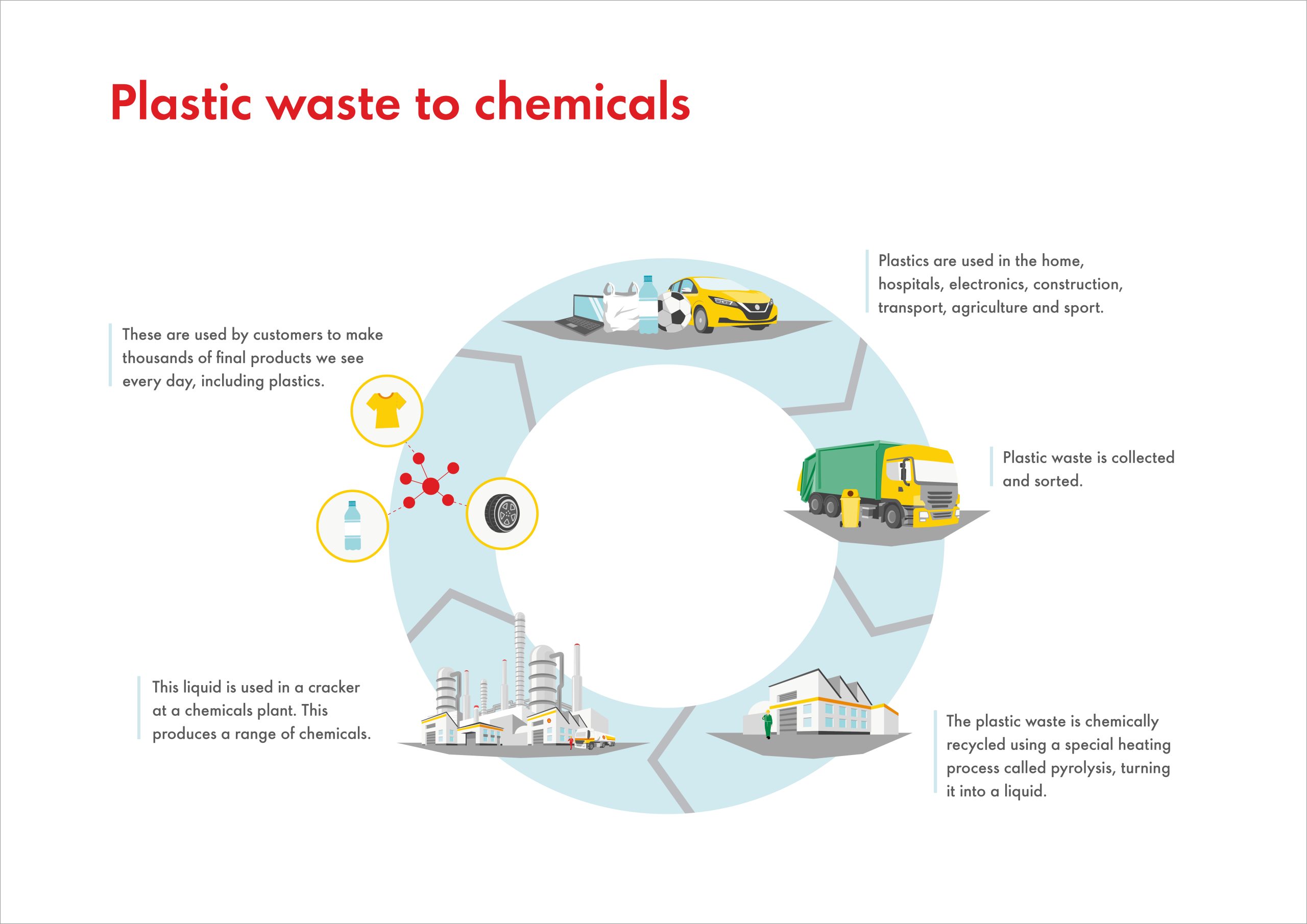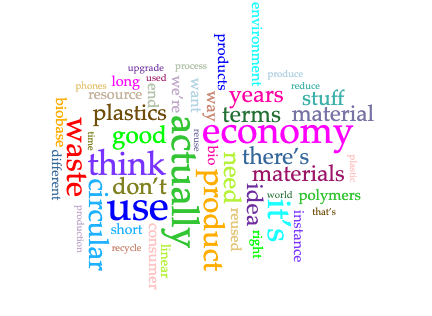Unit 1 Circular Economy: SDG12
Responsible Consumption and Production

Goal no. 12 of the 2030 Agenda for Sustainable Development aims to ensure sustainable consumption and production patterns.
Click on the arrows to reveal more information about SDG12. You don’t need to remember everything you read – the main thing is to get an overview of this Goal.
Information and targets reproduced under the terms and conditions of United Nations websites. Copyright (2023).
A reminder that links in this e-book do not open in a new tab. If you click on any link to a webpage, click the back button in your browser to return here.
Key vocabulary
Check that you know the meaning and the whole word family of these key words before you begin the Unit. (NOTE: there may be other versions of the word forms – these are the common forms in the context of SDG 12). Also notice some common collocations in bold in the ‘Why this goal? and ‘Targets’ sections above. Add any new words, word families or collocations that you would like to remember to your vocabulary book.
Verb Noun Noun person Adjective
To consume consumption consumer consumable/consumer
To produce production producer production
To resource resource resourceful
To waste waste wasteful
To recycle recycling recyclable
To be responsible responsibility responsible
To develop development developer developing/developed
To circulate circle/circularity circular
Introduction
Section 1 of Develop Your English focuses on the ways that we produce and consume things and how this affects the environment. In this Unit you’ll learn about the problems caused by consumer waste, particularly plastics, and find out about some innovative ways of dealing with plastic waste as part of a circular economy. A circular economy is a less wasteful one, and you’ll learn more about how it works in the listening. Read the quote and the text on the image before you go any further.
‘Circularity transforms our throwaway economy into one where we eliminate waste, circulate resources, and adopt nature-positive, low carbon, resource-efficient systems and actions.’
WRAP. Reproduced with kind permission. Copyright (2023). All rights reserved.

Reading – African digital innovators are turning plastic waste into value – but there are gaps
Before you read – Give your opinion
- Every year more than 12 million tonnes of plastic end up in the world’s oceans, and although a significant proportion of that waste is produced in developed, industrialised countries much of it ends up on the shores of African countries, whose citizens then have to find ways to deal with it.
- When macroplastics degrade into microplastics (tiny particles of plastic smaller than 5mm) they are eaten by marine animals, which contaminates the food chain and poses threats to human health.
Collocations
There are 6 common collocations, or word partnerships, with the word plastic in the text.
Skim read for main idea
You can find the text below.
- Read the title and predict the content of the article: ‘African digital innovators are turning plastic waste into value – but there are gaps’.
- Skim read paragraph 4 (max 1 min) and see if your predictions were accurate.
Read for detail
African digital innovators are turning plastic waste into value – but there are gaps


Dr. Seun Kolade, Professor of Entrepreneurship and Digital Transformation, Sheffield Business School, UK, and Dr. Muyiwa Oyinlola, Associate Professor, De Montfort University, UK
Plastic pollution is a growing global menace. Between 2010 and 2020, the global production of plastics increased from 270 million tonnes to 367 million tonnes. Every year, more than 12 million tonnes of plastics end up in the world’s oceans, with severe consequences for marine life. When macroplastics degrade into microplastics, they easily contaminate the food chain and pose significant threats to human health via inhalation and ingestion.
By 2030, plastic waste is expected to double to 165 million tonnes in African countries. Most of this will be in Egypt, Nigeria, South Africa, Algeria, Morocco and Tunisia.
A significant proportion of the plastic that ends up on African shores is produced in developed, industrialised countries. By 2010, it was estimated that close to 4.4 million tonnes of mismanaged plastic waste was in oceans and seas off the coast of Africa every year. A 2022 estimate has put this number at 17 million tonnes.
Growing numbers of NGOs and innovators across the continent are responding to the challenge. They are developing digital solutions to reduce plastic waste generation, and promoting reuse and recycling of plastic products. Increasingly, African tech hubs are incorporating environmental sustainability in their business models.
In our recent paper, we highlight ongoing efforts and innovations in what is called the plastic value chain. This comprises four phases, from the design of plastic products to manufacture, use, and end of life.
We found a number of initiatives that are transforming the plastic value chain into a smart, innovative and sustainable network. Most aim to improve plastic identification, collection, transport, sorting, processing and reuse. Some focus on the earlier phases: design and production of plastic products.
A whole value chain approach to the circular plastic economy is very important. While the majority of plastic waste management activities tend to focus on the use and end-of-life phases, more attention needs to be given to design and manufacture. This is where the problem of plastic waste begins.
Worldwide, attention is turning to designing simpler and standardised products that are easier to recycle and reuse.
Innovators cracking the code
A Nigerian software company, Wecyclers, operates a rewards-for-recycling platform. It offers incentives to individuals and households in low-income communities to make money and capture value from recyclable plastic waste.
Via the platform, waste collectors are connected to a fleet of locally assembled waste cargo vehicles. They use these to collect waste from subscribing households. These households are also rewarded according to the quantity of waste collected from them.
The collected waste is deposited in designated locations in the Lagos metropolis, to be collected in bulk by recyclers. This provides materials to manufacturers who turn it into new items like tissue paper, stuffing for bedding, plastic furniture, aluminium sheets and nylon bags.
The impact is significant on many levels. Firstly, by linking waste generating households with waste collectors in their neighbourhoods, the Wecycler model simplifies the logistics of collection and sorting at source, at practically no cost to households. Secondly, it enables households not only to mitigate the public health risks associated with plastic waste accumulation and mismanagement, but also to generate income. Finally, it elongates the end-of-life phase in the plastic value chain through recycling and potential reuse.
In Uganda, Yo Waste, a technology start-up, has developed a mobile, cloud-based solution that connects waste generators to the nearest waste haulers in their community. Yo Waste improves the efficiency of scheduling and waste collection. It also helps waste collection companies measure the productivity of their trucks, and gives recyclers easier access to the plastic waste.
In Zambia, Recyclebot is connecting waste sellers to waste buyers via a crowdsourcing platform that aggregates waste by type and location. In effect, the plastic waste producers dispose of their waste for free, and waste buyers overcome the cost of separation, transfer and storage.
While these are promising innovations, the main challenge is scaling. This is slow on the continent. Start-ups in the recycling industry face additional challenges like inadequate funding and an under-developed plastic market that offers limited opportunities for growth and income generation.
A significant proportion of the funds accessed by start-ups is provided as grants from international and local organisations. Pure business investments are rare, and policy interventions are way behind the curve.
What can be done
To accelerate the transition to a circular plastic economy, stakeholders from across a spectrum of organisations must work together. They include NGOs, cooperatives, think tanks and community groups. The current approach to tackle plastic waste on the continent remains scattered and inadequately co-ordinated. While efforts are being made to develop new ecosystems in many countries, key stakeholders are often missing.
In particular, African governments have a key role to play. They need to commit more to strategic investment in infrastructure, incentives and support for start-ups. African countries also need policy interventions to grow the market for circular plastic products at national and continent-wide levels.
In another study, we argued that innovators must tailor their strategies to create innovations that are functional and easy to use. This will make it easier for ordinary consumers and the general public to accept them. In turn it will help change habits of consumption and expand the market for circular plastic products.
Digital innovators, as early adopters, are critical for driving changes in the way the plastics economy works across the continent. Their innovations are also leading to knowledge exchange and cross-sectoral collaborations.
However, they also face significant institutional challenges and infrastructural limitations that are slowing down the pace of progress. By working together and pooling resources, stakeholders can achieve an impact that is much greater than the sum of their individual initiatives and contributions towards a circular plastic economy in Africa.
NB This version of the article, with permission from the author, does not include the hyperlinks to supporting articles found in the original. Click the title for the full version of the text, published under a CC BY ND licence in The Conversation, which should be used for reference and sharing.
Function – Causality
The text (‘African digital innovators are turning plastic waste into value – but there are gaps’) shows us many links between plastic pollution and the health of humans and marine life. For example, when macroplastics degrade into microplastics, they cause a threat to human health via inhalation and ingestion.
Focus on causality
Here are some constructions that describe causality – when one thing (X) causes or affects another thing (Y):
- X causes Y
- X may result in Y
- X can give rise to Y
- X is a consequence of Y
- X is a key factor in Y
- X is a major influence on Y
e.g. When macroplastics degrade into microplastics (X), they cause a threat to human health (Y) via inhalation and ingestion.
Practice
Data Visualisation – Plastic waste to chemicals
In the reading you learned about ways African digital innovators are reusing plastic waste. The international energy company Shell are also taking steps to support the circular plastic economy. Read the infographic and answer the questions below.

Download the transcript here: Unit 1 Infographic transcript
Pronunciation – Word stress in four-syllable words
When you learn a new word, noting where the main stress falls can help you communicate clearly with others. Here is a range of four-syllable words, some of which have appeared in this Unit.
Play the audio here.
- Listen to these words and notice where the main stress is:
-
- Sustainable o0oo
- Disposable o0oo
- Reusable o0oo
- Although the main stress is often on the second syllable in four-syllable words, there is a lot of variation. Listen to these words and select the correct pattern of stressed and unstressed syllables:
0ooo o0oo oo0o ooo0
-
- overproduce
- conversation
- comfortable
- developing
- distribution
- citizenship
Listening – Waste Not, Want Not (6 mins)
![]()
Credit: The Conversation, Anthill 11. Annabel Bligh, Business & Economy Editor and Podcast Producer and Gemma Ware, Editor and Co-Host. Licence: CC BY ND

Before you listen
In this listening Ana Mestre, a Research Fellow in Design at Nottingham Trent University UK, explains why a big shift is needed in the way that the stuff we buy is designed so that it can either last a lot longer, or be biodegradable (able to be changed by the action of bacteria to a natural state that will not harm the environment).
- ‘Waste not, want not’ is a proverb that means if you use a resource carefully and without extravagance (waste not) you will never be in need (want not). Do you have a similar saying in your home language?
- Mestre says that many of us are buying a lot of stuff that we’re not very good at reusing or recycling – even when we think we care about the environment. Is over-consumption possible in your local context? Is recycling an option? If yes, is this something you do?
- Mestre describes the ‘linear’ economy, and the ‘circular’ economy. Guess if this example from the listening is a description of the way that the linear economy or the circular economy works:
‘You buy a washing machine, use it for a few years until it breaks, throw it away and buy a new one’.
- Look at the word cloud created from the transcript. The most frequently used words are: use (7), think (6), economy (6), product (5), waste (5), circular (5). (‘Actually’ is a filler word that Mestre uses, rather than a topic word). With the title in mind (Waste Not, Want Not) create a sentence that uses as many of these words as possible that predicts the main point of the listening.

Listen for detail
Play the audio here.
(Or access The Conversation podcast and listen from 26.25 mins to 32.20 mins).
Listen to introduction to the podcast, and then complete the first half of the task. Drag the words that you hear into the appropriate gap to complete the summary.
Mestre goes on to talk about plastics and biobased materials. Listen for main ideas until she talks about the example of mobile phones, and complete the second half of the task.
Download Unit 1 Listening Transcript
Vocabulary – Responsible consumption and production
Writing
In this Unit you’ve learned about the ways African innovators are dealing with plastic waste as part of a circular economy. Jade Sarah Joven Suren’s story continues this theme. Jade lives in the city of Manila in the Philippines.
Read Jade’s story and write a response to it that incorporates what you know about the circular economy, and SDG12 Responsible Consumption and Production. Write about:
- What Jade and the Women Waste Warriors do, and why it is important.
- How the circular economy functions in Jade’s context.
- Why repurposing plastic waste is important.
- Why we need to think about consumption and production patterns.
- Any similar initiatives that you are aware of in your own context or elsewhere.
- Any other topic relevant to the circular economy or SDG12.
Turning Plastic to Profit
“Before, I used to just lay around the house and do house chores. Now, I am productive, I am able to earn a little even if I don’t have a job,” says Jade Sarah Joven Suren, a mother of one, who tries to augment her husband’s income as a cable TV agent and barangay (village) secretary. “More than that, I learn new skills and get to enhance my knowledge. I also get to bond with other women in the community.”
Jade is a member of Women Waste Warriors (3Ws) from Barangay 412 in Sampaloc, Manila. 3Ws is a community-based organisation promoting proper waste management within their homes and community and to explore alternative reduce, reuse, recycle (3Rs)-related livelihood projects. Jade is often working with other women, spending most of their day at the barangay daycare centre. In a busy week, they would repurpose PET bottles into 5,000 urban gardening pots to be supplied to the Philippine Council for Agricultural, Aquatic, and Natural Resources Research and Development.
To support their work, another group of warriors drives around different barangays to source used PET bottles from junk shops. It is estimated that 50kg to 100kg of plastic are diverted away from sanitary landfills every week.
Department of Economic & Social Affairs Statistics Division (2022) ‘Bringing Data to Life: SDG impact stories from across the globe.’ Available at: https://unstats.un.org/sdgs/report/2022/SDG2022_Flipbook_final.pdf
Speaking – In your local context…
Read the summary and discuss the questions below:
SDG12 Summary
Sustainable growth and development require minimising the natural resources and toxic materials used, and the waste and pollutants generated, throughout the entire production and consumption process. SDG 12 encourages more sustainable consumption and production patterns through various measures, including specific policies and international agreements on the management of materials that are toxic to the environment.
Reproduced with kind permission of the UN Environment Programme. Copyright (2023). All rights reserved.
- Is plastic waste a problem? If yes, what is the main reason for this?
- What other types of consumer waste products create an environmental problem? Who creates the waste?
- In the reading you learned about ways to reuse plastic waste, which is a pollutant. Are you a consumer of plastic products, and if yes, how much have you thought about what happens to them after you throw them away?
- In the listening you heard Ana Mestre say that as well as recycling and reusing, a big shift is needed in the way that the stuff we buy is designed so that it can either last a lot longer, or be biodegradable. Are biodegradable products available in your local context?
- What do you think the South African Anglican bishop and theologian Desmond Tutu meant when he said ‘Do your little bit of good where you are; it’s those little bits of good put together that overwhelm the world’?
- Can you give a definition for the words in bold above?
A reminder that if you have access to the internet and are studying by yourself without other people to practice your spoken English with, you can use artificial intelligence (AI) to gain fluency practice. See here for instructions and prompts.
Here are some prompts related to this Unit:
- ‘Let’s have a dialogue about plastic waste in the oceans. Tell me some interesting facts, and I will ask you for more details about them.’
- ‘Create a paragraph about the circular economy that uses C1 level vocabulary. I will ask you to explain any words that are new to me.’
- ‘Let’s talk about some of the causes and consequences of plastic pollution. You begin and ask me for my opinion after each point you make.’
- ‘What do you think Desmond Tutu meant when he said ‘Do your little bit of good where you are; it’s those little bits of good put together that overwhelm the world’?
Looking ahead to Unit 2
In Unit 2 you’ll continue the theme of the circular economy and find out about SDG 7 Affordable and Clean Energy.
- What do you know about renewable sources of energy? Are any alternative energy sources used in your local context?
- Can you imagine how air might be used as a fuel? Or how coffee grounds (the small ground-up bits of coffee beans that are left over after the coffee has been brewed) might be used as a fuel?
Use the menu bar on the left hand side of the screen to access Unit 2.

